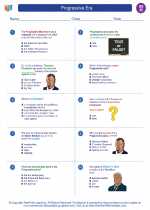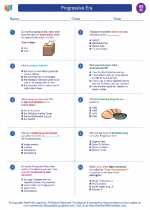Progressive Era
The Progressive Era was a period of widespread social and political reform across the United States from the 1890s to the 1920s. It was characterized by efforts to address social and economic problems caused by rapid industrialization, urbanization, and immigration. The Progressive movement aimed to improve the lives of ordinary people, combat political corruption, and regulate big business.
Key Themes and Reforms
- Political Reform: Progressives sought to increase government accountability and transparency. They advocated for direct election of senators, women's suffrage, and the use of initiatives, referendums, and recalls to give citizens more direct influence over laws and policies.
- Social Justice: Progressives worked to address issues such as child labor, unsafe working conditions, and poverty. They supported labor unions, pushed for workplace safety regulations, and advocated for social welfare programs to aid the poor and vulnerable.
- Regulation of Big Business: Progressive reformers sought to curb the power of monopolistic corporations and trusts. They promoted antitrust laws, consumer protection measures, and increased government oversight of industries such as railroads, oil, and steel.
- Conservation and Environmentalism: The Progressive Era saw efforts to preserve natural resources and protect the environment. President Theodore Roosevelt was a prominent advocate for conservation, establishing national parks and forests to safeguard America's natural heritage.
- Women's Rights: The era witnessed significant strides in the fight for women's suffrage, culminating in the ratification of the 19th Amendment in 1920, which granted women the right to vote.
Key Figures
Several influential figures emerged during the Progressive Era, including:
- Theodore Roosevelt: As president, Roosevelt championed progressive reforms, earning the nickname "Trust Buster" for his efforts to regulate big business.
- Jane Addams: A social reformer and founder of Hull House, a settlement house in Chicago that provided social services to immigrants and the urban poor.
- Ida B. Wells: An African American journalist and activist who campaigned against lynching and fought for civil rights and women's suffrage.
- Upton Sinclair: Author of "The Jungle," a novel that exposed the harsh conditions in the meatpacking industry and contributed to the passage of food safety laws.
- Carrie Chapman Catt: A leader of the women's suffrage movement who played a key role in securing the passage of the 19th Amendment.
Impact and Legacy
The Progressive Era left a lasting impact on American society and government. Many of the reforms and policies enacted during this period laid the groundwork for the modern regulatory state and expanded the role of the federal government in addressing social and economic issues. The era also set the stage for future social movements and reforms, shaping the trajectory of American politics and society in the 20th century.
Study Guide
- What were the key themes of the Progressive Era?
- Who were some key figures of the Progressive Era and what were their contributions?
- What were the major accomplishments of the Progressive Era and how did they impact American society and government?
- How did the Progressive Era pave the way for future social and political reforms in the United States?
By studying these questions and the broader context of the Progressive Era, students can gain a deeper understanding of this pivotal period in American history and its enduring significance.
[Progressive Era] Related Worksheets and Study Guides:
.◂Social Studies Worksheets and Study Guides Eighth Grade. Progressive Era

 Worksheet/Answer key
Worksheet/Answer key
 Worksheet/Answer key
Worksheet/Answer key
 Worksheet/Answer key
Worksheet/Answer key
